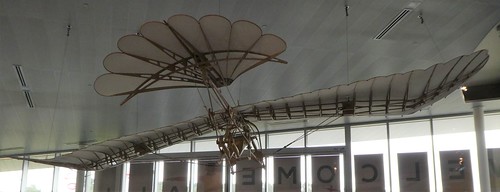The Museum of Flight in Seattle, Washington, is the largest independent, non-profit air and space museum in the world. It has more than 175 aircraft and spacecraft. Included in the museum’s displays are examples of some early airplanes.
Leonardo da Vinci’s Il Cigno (facsimile)
Leonardo da Vinci left behind drawings on many subjects including flying machines, submarines, anatomy, nature, weapons, and bridges. According to the display:
“His collection of manned flight studies contributed little to advance the dream of flight except to announce that the most celebrated thinker of the age did not find the idea of flight ridiculous.”


The machine is powered by the pilot pulling the wings down by pushing with his arms. Technically, this is an ornithopter, an aircraft that is held aloft and propelled by wing movements. According to the display:
“No successful human-powered ornithopter has ever been built because human musculature and metabolism are woefully inadequate for the job.”
The Montgolfière (1/10 scale model)
The first practical hot air balloon was developed by French brothers Joseph-Michel Montgolfier (1740-1810) and Jacques-Ètienne Montgolfier (1745-1799). Their first public balloon demonstration was in 1783. The balloon rose to an altitude of about 6,000 feet, traveled more than 1 mile, and stayed aloft for 10 minutes.
Lilienthal Monoplane Glider (1893 reconstruction)
Beginning in 1891, German inventor Otto Lilienthal and his brother began building monoplane and biplane gliders with arched, bat-like wings. According to the display:
“The secret to Lilienthal’s gliders was cambered or curved wings. He studied birds and their anatomy and developed his glider’s wings with the same arched shape to produce maximum lift.”
Lilienthal achieved glides up to 1,150 feet.


Chanute-Herring Glider (1895 reproduction)
In 1896, Octave Alexander Chanute (1833-1910) tested three new glider designs at Miller Beach on Lake Michigan. Initially Chanute and his co-designer Augustus Herring (1867-1926) tried a three-wing machine which they found to be unstable and so they removed the bottom wing. Their glider had hundreds of controlled flights up to 359 feet for as long as 14 seconds.


Rumpler Taube (reproduction)
The origins of the Taube (Dove) are found in the nineteenth century with German glider Pioneer Otto Lilienthal (1848-1896), the first person to make well-documented, repeated successful flights with gliders. Following his death in a flying accident, his bird-like designs were modified and improved by numerous others. The first Taube flew in 1910. At the beginning of World War I, Taubes were built in great numbers.

According to the display:
“For the first months of the conflict, Taubes flew with the Central Powers armys in the role of scout aircraft. As new Allied aircraft began arriving at the front, the unarmed Taubes began to seem frighteningly unmaneuverable and sickeningly slow to its German flyers. The Taube was soon transferred to the role of training students.”
 Detail of the tail.
Detail of the tail.


 The museum’s replica has an original Mercedes D.IIIa engine.
The museum’s replica has an original Mercedes D.IIIa engine.
1902 Wright Glider (reproduction)
After reading about Otto Lillienthal’s death in 1896, Orville and Wilbur Wright became interested in flying. According to the display:
“When their first gliders didn’t provide the lift that Lilienthal’s calculations said they should, the Wrights built a wind tunnel and compiled the first reliable tables of air pressures on curved surfaces. Their next glider, the 1902 version, had much improved aerodynamic qualities and lead the way to their first powered flights the following year.”

Wright Flyer Reproduction (1903)
This is considered the world’s first powered airplane. The first flight went 120 feet in 12 seconds. By the end of the day, Wilbur Wright flew the machine 852 feet in 59 seconds.




More airplane photo tours
Historic Flight: Beaver airplanes (photo diary)
Museum of Flight: World War II bombers (photo diary)
Museums 201: Jet airplanes of the 1940s (photo diary)
Historic Flight: Grumpy (photo diary)
Museum of Flight: The First Fighter Plane (photo diary)
Museum of Flight: Naval aircraft (photo diary)
Evergreen Aviation: Multi-Engine Airplanes (photo diary)
Olympic Flight Museum: Helicopters (photo diary)


